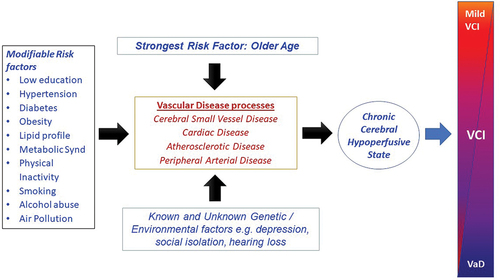Figures & data
Figure 1. Classification of VCI according to level of impairment into mild VCI and major VCI (VaD). Major VCI (VaD or frank dementia of vascular origin) is classified into four main subtypes as depicted. The estimated 6-month temporal basis for cognitive decline after stroke differentiates PSD from other forms of major VCI (VaD). We propose that ICH-VCI is included since cerebral hemorrhages cause hemorrhagic dementia, which is more common in Asia and Africa than in Europe and the U.S.A. Abbreviations: AD, Alzheimer’s disease; DLB, dementia with Lewy bodies; FTD, frontotemporal dementia; ICH, intracerebral hemorrhage; PSD, post stroke dementia. PSD-# denotes other possible combinations when comorbid neuropathology is present in mixed dementias. Figure adapted from [Citation15] with permission of John Wiley & sons.
![Figure 1. Classification of VCI according to level of impairment into mild VCI and major VCI (VaD). Major VCI (VaD or frank dementia of vascular origin) is classified into four main subtypes as depicted. The estimated 6-month temporal basis for cognitive decline after stroke differentiates PSD from other forms of major VCI (VaD). We propose that ICH-VCI is included since cerebral hemorrhages cause hemorrhagic dementia, which is more common in Asia and Africa than in Europe and the U.S.A. Abbreviations: AD, Alzheimer’s disease; DLB, dementia with Lewy bodies; FTD, frontotemporal dementia; ICH, intracerebral hemorrhage; PSD, post stroke dementia. PSD-# denotes other possible combinations when comorbid neuropathology is present in mixed dementias. Figure adapted from [Citation15] with permission of John Wiley & sons.](/cms/asset/0f20316d-6ca9-487b-a65f-7a7d82720201/iern_a_2273393_f0001_oc.jpg)
Table 1. Unmodifiable and modifiable risk factors for VCI*.
Figure 2. Scheme illustrates how various risk factors may influence the cerebral as well as systemic vasculature at distinct levels to induce chronic brain or cerebral hypoperfusion and result in variable degrees of cognitive impairment over time. Several genetic and environmental factors may modify the intensity of vascular damage.

Table 2. Pharmacological approaches to control VRFs and prevent VCI progression.
Table 3. Lifestyle and non-pharmacological approaches to prevent VCI.
